
Eucalyptus elata, commonly known as the river peppermint or river white gum, is a species of medium to tall tree that is endemic to eastern Australia. It has rough, compacted bark on the lower trunk, smooth bark above, lance-shaped to curved adult leaves, green to yellow flower buds arranged in groups of eleven to thirty or more, white flowers and hemispherical or shortened spherical fruit.

Eucalyptus porosa, commonly known as mallee box, Quorn mallee or water mallee, is a species of mallee or a tree that is endemic to southern Australia. It has rough, fibrous or flaky bark on the trunk and larger branches, smooth greyish bark above, lance-shaped adult leaves, flower buds in groups of seven, white flowers and barrel-shaped or shortened spherical fruit.
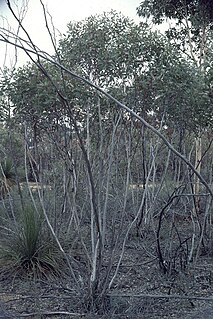
Eucalyptus exilis, commonly known as Boyagin mallee, is a species of mallee that is endemic to Western Australia. It has thin stems with smooth bark, lance-shaped adult leaves, flower buds in groups of eleven, white flowers and barrel-shaped to shortened spherical fruit.

Eucalyptus fruticosa is a species of mallee that is endemic to Western Australia. It has rough, fibrous or flaky bark on the trunk, sometimes also on the larger branches, smooth pale brownish bark above, linear to narrow elliptical adult leaves, flower buds in groups of between seven and eleven, white to cream-coloured flowers and barrel-shaped to shortened spherical fruit.
Eucalyptus glomerosa, commonly known as jinjulu, is a species of mallee that is endemic to inland Australia. It has rough, fibrous and flaky bark near the base, smooth bark above, egg-shaped to lance-shaped adult leaves, flower buds usually in groups of seven, cream-coloured flowers and conical to hemispherical fruit. It is mainly found in the Great Victoria Desert of South Australia but also grows in eastern parts of Western Australia.

Eucalyptus johnsoniana, commonly known as Johnson's mallee, is a species of mallee that is endemic to Western Australia. It has smooth, greyish brown bark, sometimes with flaky to fibrous brownish bark at the base, lance-shaped adult leaves, flower buds in groups of seven, creamy white flowers and shortened spherical fruit with an unusually small opening.

Eucalyptus latens, commonly known as narrow-leaved red mallee, is a species of mallee that is endemic to the south-west of Western Australia. It has smooth grey and coppery bark, linear to narrow lance-shaped adult leaves, flower buds in groups of seven to eleven or more, creamy white flowers and small barrel-shaped to shortened spherical fruit.
Eucalyptus neutra, commonly known as the Newdegate mallee, is a species of mallee that is endemic to the south-west of Western Australia. It has greyish bark, lance-shaped adult leaves, flower buds usually in groups of seven, pale yellow to white flowers and barrel-shaped to shortened spherical fruit.
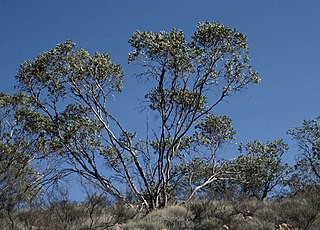
Eucalyptus oxymitra, commonly known as the sharp-capped mallee, is a species of mallee that is endemic to remote parts of Central Australia. It has rough bark on the trunk, smooth greyish bark above, lance-shaped to egg-shaped adult leaves, flower buds in groups of seven, white to pale yellow flowers and hemispherical fruit.
Eucalyptus subtilis, commonly known as narrow-leaved mallee, is a species of mallee that is endemic to Western Australia. It has smooth bark, linear adult leaves, flower buds in groups of nine or eleven, cream-coloured flowers and usually cup-shaped fruit.
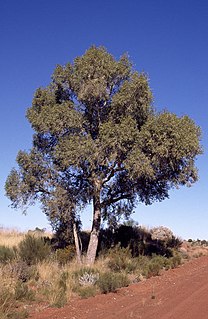
Corymbia chippendalei, commonly known as the sand-dune bloodwood or sandhill bloodwood, is a species of small tree or a mallee that is endemic to desert country in central Australia. It has rough bark on part or all of the trunk, lance-shaped adult leaves, flower buds in groups of seven, white flowers and shortened spherical fruit.
Eucalyptus wyolensis, commonly known as the Wyola mallee, is a species of mallee that is endemic to South Australia. It has rough bark on the base of the stems, smooth grey to brown bark above, heart-shaped to egg-shaped adult leaves arranged in opposite pairs, flower buds in groups of seven to eleven, pale yellow flowers and cup-shaped to barrel-shaped fruit.
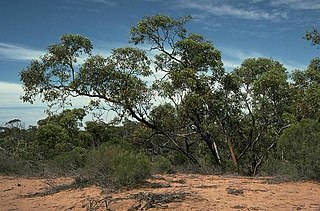
Eucalyptus yumbarrana, commonly known as the Yumbarra mallee is a species of mallee that is endemic to South Australia. It has rough, flaky bark on the lower trunk, smooth bark above, egg-shaped to lance-shaped adult leaves, flower buds in groups of seven, creamy white to yellow flowers and shortened spherical to cup-shaped fruit.

Eucalyptus buprestium, also known as the apple mallee or ball-fruited mallee, is a small mallee that is endemic to an area along the south coast of Western Australia. It has smooth bark, narrow lance-shaped adult leaves, flower buds arranged in groups of between nine and fifteen, white flowers and almost spherical fruit with a small opening.

Eucalyptus cylindrocarpa, commonly known as the woodline mallee, is a species of mallee that is endemic to Western Australia. It has mostly smooth bark, sometimes with loose fibrous or flaky bark near the base of the trunk, linear to lance-shaped or curved adult leaves, flower buds in groups of seven, nine or eleven and cylindrical to barrel-shaped fruit.

Eucalyptus desmondensis, commonly known as Desmond mallee, is a species of slender mallee that is endemic to a small area in the south-west of Western Australia. It has smooth bark, lance-shaped adult leaves, flower buds in groups of between nine and nineteen, cream-coloured to pale yellow flowers and cup-shaped to barrel-shaped fruit.
Eucalyptus dolichocera is a species of mallee that is endemic to Western Australia. It has rough, ribbony bark near the base, smooth grey to brownish above, lance-shaped adult leaves, flower buds arranged in groups of seven, yellow to cream-coloured flowers and cup-shaped or urn-shaped fruit.
Eucalyptus opimiflora, commonly known as northern silver mallee, is a species of mallee that is endemic to near-coastal areas of Western Australia between Perth and Geraldton. It has smooth grey bark, lance-shaped adult leaves, flower buds in groups of between seven and fifteen, creamy white flowers and conical to hemispherical fruit.
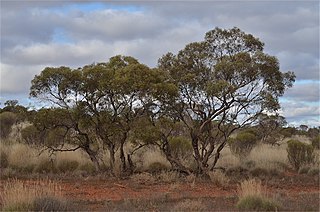
Eucalyptus socialis subsp. socialis, commonly known as the summer red mallee, is a subspecies of mallee that is endemic to inland south-eastern Australia. It usually has rough bark on the base of the trunk, smooth bark above, lance-shaped adult leaves, flower buds in groups of between seven and eleven, pale creamy white flowers and barrel-shaped to urn-shaped or spherical fruit.
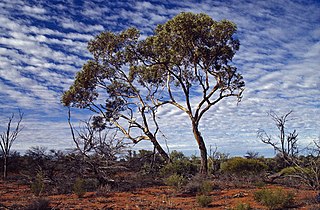
Eucalyptus socialis subsp. victoriensis, commonly known as the red mallee, is a subspecies of mallee that is endemic to southern inland Australia. It usually has rough bark on the base of the trunk, smooth bark above, lance-shaped adult leaves, flower buds in groups of between seven and eleven, pale creamy yellow flowers and barrel-shaped to urn-shaped or spherical fruit.
















